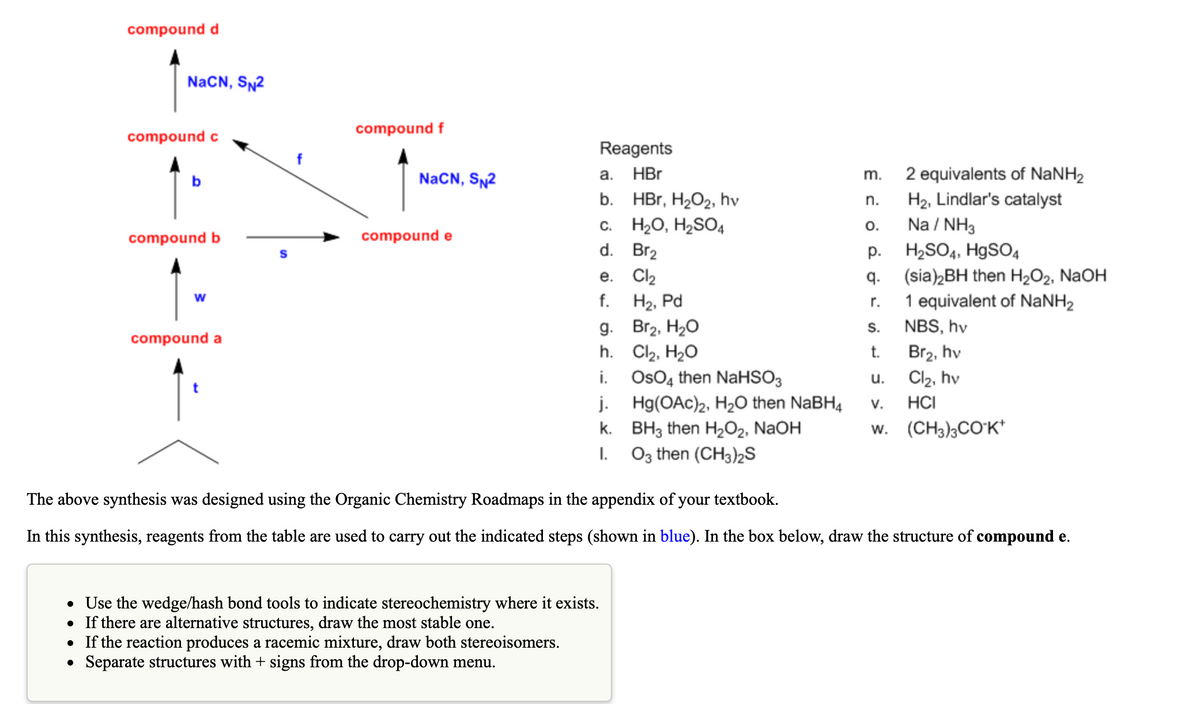compound d NaCN, SN2 PLE compound f compound c Reagents f NACN, SN2 HBr 2 equivalents of NANH2 a. m. b b. HBr, H2O2, hv c. H20, H2SO4 d. Br2 Cl2 H2, Pd g. Br2, H20 h. Cl2, H2O i. OsO4 then NaHSO3 H2, Lindlar's catalyst Na / NH3 n. O. compound b compound e H2SO4, H9SO4 (sia)2BH then H2O2, NaOH 1 equivalent of NANH2 е. q. w f. S. NBS, hv compound a Br2, hv Cl2, hv t. u. j. Hg(OAc)2, H2O then NaBH4 k. BH3 then H2O2, NaOH Og then (CH3)2S V. HCI w. (CH3)3CO'K* I. The above synthesis was designed using the Organic Chemistry Roadmaps in the appendix of your textbook. In this synthesis, reagents from the table are used to carry out the indicated steps (shown in blue). In the box below, draw the structure of compound e. • Use the wedge/hash bond tools to indicate stereochemistry where it exists. • If there are alternative structures, draw the most stable one. • If the reaction produces a racemic mixture, draw both stereoisomers. Separate structures with + signs from the drop-down menu.
Carbohydrates
Carbohydrates are the organic compounds that are obtained in foods and living matters in the shape of sugars, cellulose, and starch. The general formula of carbohydrates is Cn(H2O)2. The ratio of H and O present in carbohydrates is identical to water.
Starch
Starch is a polysaccharide carbohydrate that belongs to the category of polysaccharide carbohydrates.
Mutarotation
The rotation of a particular structure of the chiral compound because of the epimerization is called mutarotation. It is the repercussion of the ring chain tautomerism. In terms of glucose, this can be defined as the modification in the equilibrium of the α- and β- glucose anomers upon its dissolution in the solvent water. This process is usually seen in the chemistry of carbohydrates.
L Sugar
A chemical compound that is represented with a molecular formula C6H12O6 is called L-(-) sugar. At the carbon’s 5th position, the hydroxyl group is placed to the compound’s left and therefore the sugar is represented as L(-)-sugar. It is capable of rotating the polarized light’s plane in the direction anticlockwise. L isomers are one of the 2 isomers formed by the configurational stereochemistry of the carbohydrates.

Trending now
This is a popular solution!
Step by step
Solved in 2 steps with 1 images









